SDXL ControlNet
SDXL ControlNet empowers users with unprecedented control over text-to-image generation in SDXL models. By incorporating conditioning inputs, users can achieve more refined and nuanced results, tailored to their specific creative vision. It achieves this by introducing the concept of conditioning inputs, which provide additional information to guide the image generation process. This allows for precise control over various aspects of the final image. A key feature of SDXL ControlNet is its ability to leverage control images as conditioning inputs. These control images can include:
-
Depth maps: Encode spatial arrangements and distances within an image.
-
Canny edge maps: Capture outlines and edges, ideal for tasks like comic book art and architectural visualization.
-
Human pose keypoints (from OpenPose): Enable control over character pose, gestures, and dynamics in animations and character design.
-
Free-form sketches and scribbles: Allow for rapid concept iteration and exploration in tasks like concept art and children's book illustrations.
-
Edge Extraction : Allows for extracting edges from images to create a sketch-like representation.
Specific Applications of ControlNet
-
Canny ControlNet: Ideal for generating comic book art with bold outlines and ink-like strokes, or highlighting building structures and edges in architectural visualizations.
-
Depth ControlNet: Well-suited for populating virtual reality environments with realistic textures or showcasing products with accurate depth cues in product design.
-
Openpose ControlNet: Particularly useful for animating characters with precise poses in character animation or creating virtual fashion models for showcasing clothing in fashion design.
-
Scribble ControlNet: Enables rapid concept iteration through sketches and scribbles, ideal for tasks like concept art and children's book illustrations.
-
SoftEdge ControlNet: It’s useful for tasks like converting photos into sketch-like versions or enhancing existing images with soft edges.
Other Popular Models
sdxl-img2img
SDXL Img2Img is used for text-guided image-to-image translation. This model uses the weights from Stable Diffusion to generate new images from an input image using StableDiffusionImg2ImgPipeline from diffusers

sdxl-inpaint
This model is capable of generating photo-realistic images given any text input, with the extra capability of inpainting the pictures by using a mask

codeformer
CodeFormer is a robust face restoration algorithm for old photos or AI-generated faces.

sd2.1-faceswapper
Take a picture/gif and replace the face in it with a face of your choice. You only need one image of the desired face. No dataset, no training
